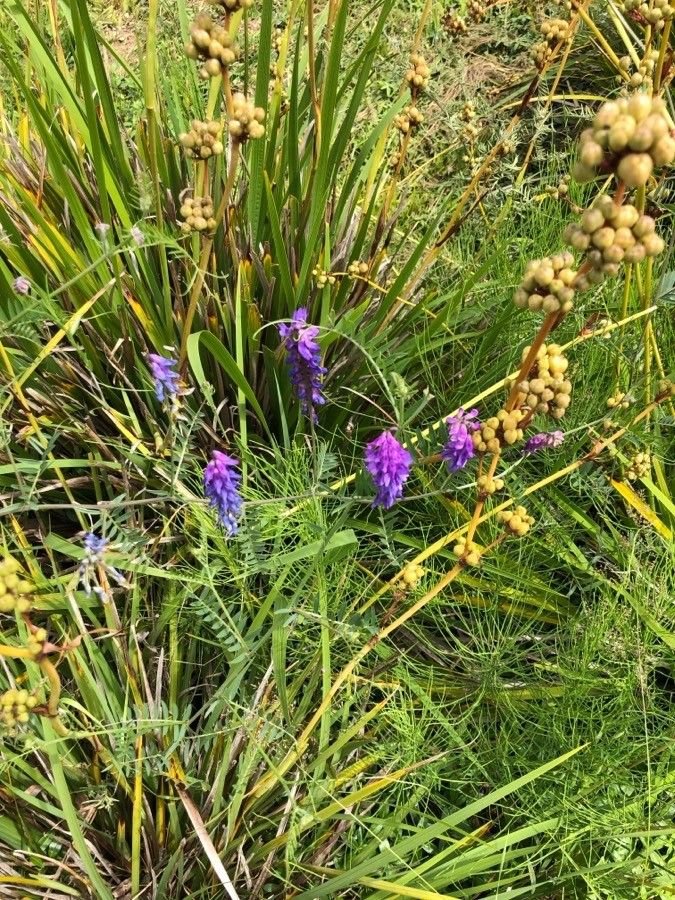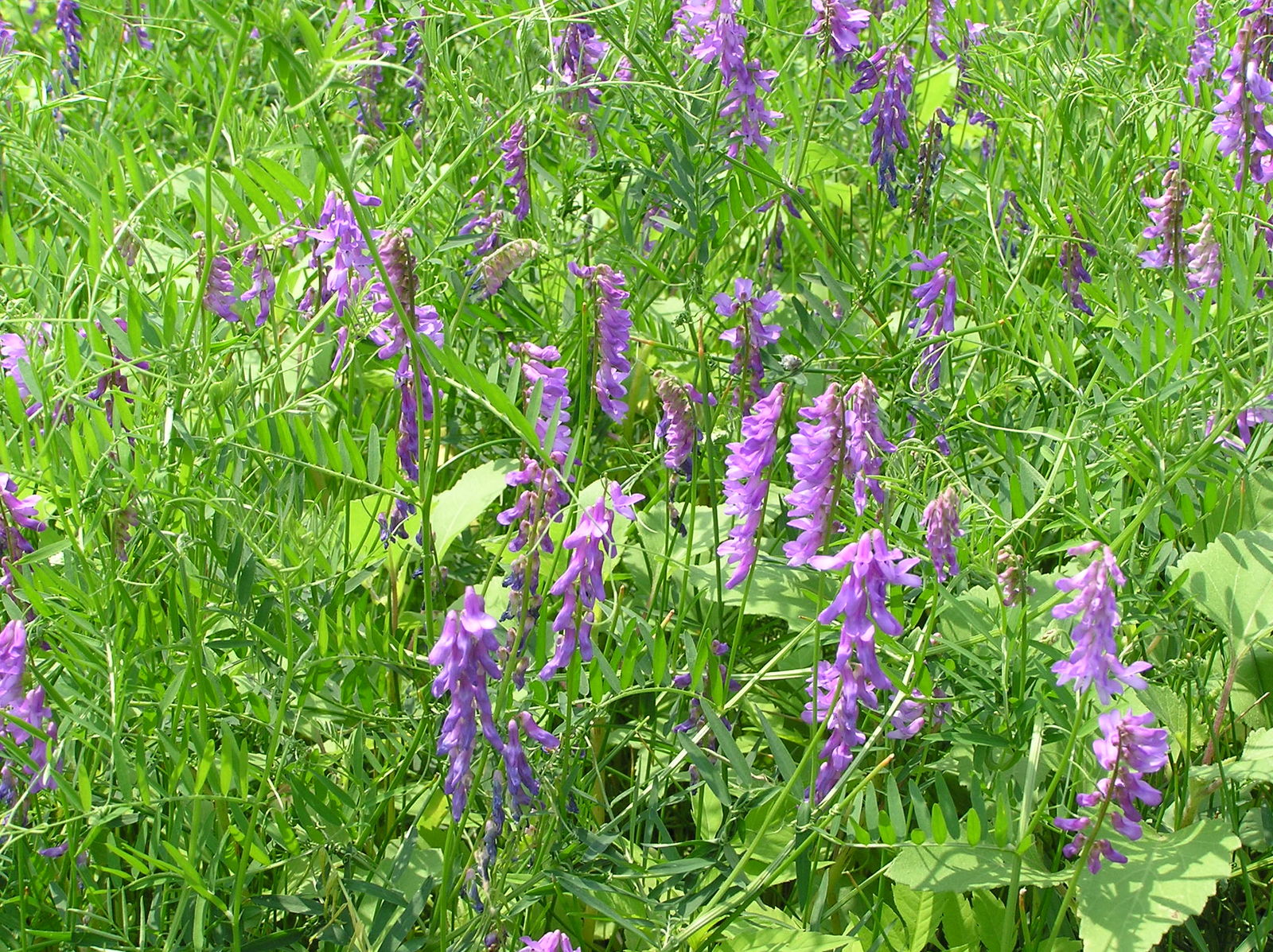Tufted Vetch
vicia cracca
Also known as: ["Bird Vetch","Cow Vetch","Tufted Vetchling"]
Overview
A climbing, herbaceous perennial legume with delicate, pea-like flowers and compound leaves often ending in tendrils.
Benefits & Perks
["wildlife attractant (bees, butterflies, birds)","drought tolerant","shade tolerant"]
Botanical Classification
| Phylum: | Magnoliophyta |
| Class: | Magnoliopsida |
| Order: | Fabales |
| Family: | Fabaceae |
| Genus: | Vicia |
| Botanical Name: | Vicia cracca |
Plant Characteristics
Basic Information
- Category: Herbs & Weeds
- Suitable Location: garden bed or border, prefers open areas
- Suitable For:
- Is Weed: No
- Allergenicity: low
Environmental Needs
- Climate: {"temperatureRange":"0–30°C"}
- Hardiness: {"zones":"3–8"}
- Misting: rarely required, only if ambient humidity is very low
- Drainage: Moderate to fast-draining.
- Soil Type: Well-draining, loamy soil with added organic matter.
Maintenance Level
- Maintenance Level: low
- Toughness Level: high
- Pruning Frequency: Light pruning can be done anytime; major pruning in late winter or early spring before new growth begins.
- Pruning Intensity: Light to moderate, depending on desired shape and health of the plant.
Care Details
Ideal Sunlight Coverage:
Full sun to partial shade (4–6 hours of direct sunlight daily). Adjust for intense summer sun by providing afternoon shade.
Sunlight Tolerance Tips:
Acclimate plants gradually to direct sunlight to avoid scorching. For indoor placement, use a south-facing window with filtered light.
Care Requirements
Care Difficulty
easymoderate
Sunlight
full sun to partial shade
Rotate plants for even growth; use sheer curtains in summer; avoid direct midday sun.
Watering
every 7–10 days during active growth, reduce in winter
Water deeply but infrequently; ensure good drainage; adjust frequency based on season and growth stage.
Soil
well-drained, loamy soil with moderate organic matter
pH: Slightly acidic to neutral (pH 6.0–7.0).
Ensure good aeration; avoid waterlogging; enrich with organic matter annually.
Temperature
Prefers cool to moderate temperatures (60–75°F or 15–24°C). Tolerates cooler spring and fall conditions but avoids extreme heat.
Monitor temperature changes; protect from frost; avoid sudden temperature shifts.
Fertilizing
every 4–6 weeks during spring and summer
Apply fertilizer after watering; avoid contact with roots; flush soil occasionally to prevent salt buildup.
Propagation
Methods
Stem cuttings or division. Stem cuttings are more common for home growers.
Step-by-Step Propagation Guide
- Take 4–6 inch cuttings.
- Remove lower leaves.
- Dip in rooting hormone.
- Plant in medium.
- Maintain humidity.
Best Time: Early spring or late summer when the plant is actively growing.
Environment
High humidity (70–80%), indirect light, and consistent warmth (65–75°F or 18–24°C).
Medium
Well-draining potting mix with perlite or sand for cuttings.
Hormone
Rooting hormone is recommended for faster and more reliable rooting.
Timeline
Roots develop in 3–4 weeks; new growth appears in 6–8 weeks.
Tools Needed
Pruning shears, rooting hormone, small pots, plastic bags or propagator.
Quick Tips
Use healthy, non-flowering stems; keep soil consistently moist; provide bottom heat if possible.
Pruning & Repotting
Pruning Guide
Method
Pinch back tips for bushier growth; trim leggy stems; remove dead or yellowing leaves.
Pruning Plan
Prune to maintain shape, encourage bushier growth, and remove dead or diseased parts.
Tools
Pruning shears, gloves, disinfectant for tools.
Checklist
Disinfect tools; prune dead/diseased parts; shape as needed; clean up debris.
Repotting Guide
Best Season
Early spring before active growth begins.
Pot Size
Increase pot size by 1–2 inches in diameter.
Method
Remove plant gently; trim any circling roots; place in a slightly larger pot with fresh soil; water thoroughly.
Suggestions
Repot every 2–3 years or when roots fill the container. Vicia cracca prefers slightly crowded roots but benefits from fresh soil.
Checklist
Choose appropriate pot; prepare new soil; handle roots carefully; water after repotting.
Advanced Care Tips
Watering Mastery
Watering Checklist
Check soil moisture; water deeply; ensure drainage; adjust for season.
How to Apply Water Properly
Water at the base of the plant, ensuring moisture reaches the root zone. Water early in the day to minimize evaporation and fungal issues. Avoid wetting foliage to prevent disease.
Watering Schedule Tips
Water moderately during active growth in spring and summer, reducing frequency in fall and winter to prevent root rot. Allow the top inch of soil to dry between waterings.
Soil Improvement
Add compost or well-rotted manure for fertility; mix in perlite or sand for drainage.
Temperature Stress Management
Signs of Temperature Issues
Wilting, yellowing leaves, stunted growth, or flower bud drop in extreme heat or cold.
Cold Stress
Low temperatures slow growth and may cause leaf damage or dormancy if below 50°F (10°C).
Solution: Provide frost protection in cold climates; mulch around roots to insulate; move potted plants indoors if temperatures drop below 40°F (4°C).
Hot Stress
Excessive heat (above 85°F or 29°C) can cause leaf scorch, wilting, and reduced flowering.
Solution: Provide shade during peak sun hours; increase watering frequency; use mulch to retain soil moisture.
Fertilizing Guide
Fertilizing Checklist
Check fertilizer type; dilute properly; apply during active growth; avoid dormant periods.
Fertilizing Method
Use a balanced, water-soluble fertilizer diluted to half strength every 4–6 weeks during spring and summer. Avoid fertilizing in fall and winter.
Common Problems & Solutions
Toxicity Warning
Cats
Slightly ToxicCats may experience mild gastrointestinal symptoms if they consume Vicia cracca seeds or young pods, due to the alkaloid content.
⚠️ Symptoms:
🌿 Toxic Parts:
⚡ Toxic If:
if eaten
Dogs
Slightly ToxicIn dogs, ingestion of Vicia cracca seeds and young pods can lead to mild gastrointestinal upset due to the presence of alkaloids.
⚠️ Symptoms:
🌿 Toxic Parts:
⚡ Toxic If:
if eaten
Humans
Slightly ToxicVicia cracca contains alkaloids that can cause mild gastrointestinal distress and other mild symptoms upon ingestion. The physiological impact is generally limited to the digestive system.
⚠️ Symptoms:
🌿 Toxic Parts:
⚡ Toxic If:
if eaten
Frequently Asked Questions
Q: Is Vicia cracca invasive?
A: Yes, it can be invasive in some regions due to its vigorous growth and climbing habit.
Q: Does Vicia cracca have any medicinal uses?
A: Historically, it has been used in folk medicine, but modern applications are limited.
Q: Can Vicia cracca be grown in containers?
A: It can be grown in large containers, but it requires support for climbing.
Quick Reference
| Family: | Fabaceae |
| Care: | easy |
| Light: | full sun to partial shade |
| Water: | every 7–10 days during activ |
Get Expert Care Tips
Download the Plantious app for personalized care reminders and plant identification!
Google Play App Store








